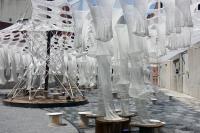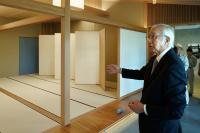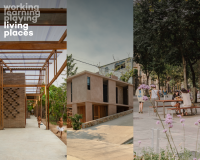Zen Sushi Restaurant
Rome, Italy
The project is inspired by the walkways in the forest bordered by the succession of matt black and glossy red-orange wooden portals, which lead to the temples of Fushimi Inari in Kyoto, of which reproduces colors and suggestions.
Zen Sushi was the first Japanese restaurant to bring in Italy the Kaiten, the particular conveyor belt to serve freshly prepared sushi on colored saucers indicating prices. On the tenth anniversary of the restaurant in Rome the property wanted to give a new look. The design challenge was to create a space with a truly Japanese essence in a contemporary way.
The dynamism of the kaiten suggests to emphasize the dynamic dimension of the space. The project, conceived with the Kyoto walkways in mind, is thought as a process, a succession of steps and changes of direction that gradually reveal the spaces of the restaurant and never close the perspective. To each change of direction corresponds a subsequent opening that invites to continue exploring the space. The straight lines of the suspended ceilings and the infinite sequence of the vertical elements of the walls underline this dynamic. Red orange reflecting suspended ceilings emphasize the visual perspectives and identify the different areas of the hall, the sushi bar and a small more intimate room in the bottom, dividers and wall coverings formed by the close succession of thousand of vertical black timber elements, lacquered from one meter up of glossy red-orange, drive and mark the going through, while a rice paper backlit wall underlines the central focus of the restaurant, the Kaiten and the open workstation of the sushi master. All the space is conceived as an architectural promenade rather than a simple decor of the interior.
As the works should have to be done in the four weeks of the august holidays the attention was focused on a few elements that could strongly characterize the space while the spatial box was neutralized with blacks floors and black ceilings and air systems. Ceilings, wall coverings, and a backlit wall are all designed as separate elements between each others, like suspended inside the space in such a way that they could be manufactured and assembled independently from each other and from installations allowing to accelerate the phase of realization on site.
- Architects
- Carlo Berarducci Architecture
- Location
- Via degli Scipioni, 243, Rome, Italy
- Year
- 2014










